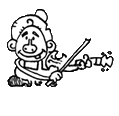Overview
An easy, familiar song like Twinkle Little Star is not only good for beginner violinists, but it’s also a good practice tool for more advanced players. In this lesson, I’ll give you some ideas for taking these timeworn songs an re-inventing them.
Beginner Practice With Familiar Songs
Familiar songs are a great way to get up and running with the violin as a beginner.
Since you already “hear them in your head,” you can more easily work it out on the violin. You can focus on translating the melody from your brain to the instrument. Plus, you have immediate feedback if you make a mistake. If you’re learning a tune that’s not familiar, then you may be unsure whether you made a mistake or not.

Once you can make it through the tune, then you can improve your technique. Playing this familiar tune allows you to focus on improving your different skills. If you know the melody well, then it’s easier to break it into small “Learning Chunks”.
For example, as you’re playing Twinkle Little Star, you can turn your attention to these various aspects of your playing:
- Tuning – Are the notes in tune? If not, which ones are out? Play small chunks of the familiar song to improve the tuning.
- Timing – Are you playing the correct note lengths? Are you playing at a consistent tempo?
- Tone – How is the sound of each note?
- Flow – Are you smoothly connecting different parts? Are you able to balance the 10,000 things you have to remember as you play?
Focus on one aspect at a time. This is a lot easier if the tune is familiar.
Intermediate Practice With Familiar Songs
But playing familiar songs is not just for beginners. Once you’ve mastered a song, you can use it as a warmup. One of my students started every practice by playing easy songs saying that “they made her feel like a violinist”. As your repertoire grows, you can play different “easy” songs as warmups. Not only does this keep things interesting, but it’s also a way to continuously review what you’ve learned.
You can also practice ear-training with familiar songs.
Advanced Practice With Familiar Songs
A good practicipant will leverage familiar songs to practice more advanced skills.
Here are some other advanced skills you can practice with a simple, familiar song like “Twinkle, Twinkle, Little Star.”
- Dynamics
- Bowing textures: staccato, tremolo, bouncing
- Rhythmic variation
- Slur
- Transposition
- Double stops (two notes at once)
- Vibrato
- Irish embellishments
- Higher positions
- Improvisation: alternate between the tune and improv in D pentatonic
When you make an easy song, more challenging, it’s called desirable difficulty. This means that you are constantly pushing yourself to learn. Ultimately, it makes your practice sessions more engaging. It’s like a video game that you win 50% of the time. If you always want, it would be boring, if you never won, he would be frustrated.
Think of these familiar songs as life-long friends that help you on each step of the journey.
Turn a new song into a familiar song
Intentional practice, any new song can become a familiars. Here is some things you can do to take a newer song to the point with intentional practice.
You are some intentional practices you can do to take a newer song to the point of being familiar.
- Memorize the song (do this in small chunks at a time)
- Listen to the song (during practice sessions and at other times of day)
- Sing the song (or hum or whistle; this brings it into the body)
- Audiate the song (hear the music in your head)
Note: I’ve been using the term “song” to refer to any kind of musical “piece” or “tune” or “melody”.
Examples
Practicing Vibrato with Mary Had A Little Lamb
Learn more here: Mary Had A Little Lamb & Vibrato
Practice Double Stops with Auld Lang Syne
Practice Singing What You Play With Little Liza Jane
Here are the steps to improve your skills:
- Warm up by playing a simple version of the song.
- Then just sing the song.
- Then practice alternating between singing and playing small chunks in a loop like “I gotta girl”.
- And then loop on bigger chunks.
Singing what you play is a fun way to develop your ear. It will help you to play in tune, learn melodies and jam with others.
Learn the full tune here: Little Liza Jane
Practice Singing While Playing Backup with Freres Jacques
Familiar songs on FiddleHed
These lessons are free for unpaid users. Hop on in and start learning!
- Auld Lang Syne
- Bile ’em Cabbage Down
- Freres Jacques
- Mary Had A Little Lamb
- Ode to Joy
- Oh Susannah
- Scarborough Fair
- Twinkle, Twinkle Little Star
Pay it forward
You might find that someday your journey with a familiar song comes full circle. You’ve become a proficient violinist thanks to the easy tune practice. And then a friend or family member is interested in learning the violin. You can use these tunes to teach them, spreading the joy of music. Luckily, that’s what happened to me!
Two ways I can help you level up your fiddling
- Sign up for the FiddleHed newsletter below, then get high-value tips and lessons delivered to your inbox.
- Sign up for the Free Two-week Trial. You’ll get full access to all courses and group lessons. Plus, I’ll send you some free lessons tailored to your current skill level.
Thanks for being here 🙏
Further learning
Fiddling With Desirable Difficulty
The Four Elements of Good Sound
Expand Your Musical Mind With Audiation
